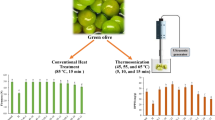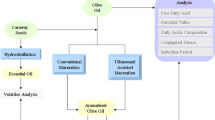Abstract
Three different flavoring methods of olive oil were tested employing two different herbs, thyme and oregano. The traditional method consist in the infusion of herbs into the oil. A second scarcely diffused method is based on the addition of herbs to the crushed olives before the malaxation step during the extraction process. The third innovative method is the implementation of the ultrasound before the olive paste malaxation. The objective of the study is to verify the effect of the treatments on the quality of the product, assessed by means of the chemical characteristics, the phenol composition and the radical scavenging activity of the resulting oils. The less favorable method was the addition of herbs directly to the oil. A positive effect was achieved by the addition of herbs to the olive paste and other advantages were attained by the employment of ultrasound. These last two methods allow to produce oils “ready to sell”, instead the infused oils need to be filtered. Moreover, the flavoring methods applied during the extraction process determine a significant increment of phenolic content and radical scavenging activity of olive oils. The increments were higher when oregano is used instead of thyme. Ultrasound inhibited the olive polyphenoloxidase, the endogenous enzyme responsible for olive oil phenol oxidation. This treatment of olive paste mixed with herbs before malaxation was revealed as the most favorable method due to the best efficiency, reduced time consumption and minor labor, enhancing the product quality of flavored olive oil.

Similar content being viewed by others
References
Clodoveo ML, Camposeo S, De Gennaro B, Pascuzzi S, Roselli L (2014) In the ancient world, virgin olive oil was called “liquid gold” by Homer and “the great healer” by Hippocrates. Why has this mythic image been forgotten? Food Res Int 62:1062–1068
Sospedra I, Soriano JM, Mañes J (2010) Assessment of the microbiological safety of dried spices and herbs commercialized in Spain. Plant Foods Hum Nutr 5(4):364–368
Singh G, Kawatra A, Sehgal S (2001) Nutritional composition of selected green leafy vegetables, herbs and carrots. Plant Foods Hum Nutr 56(4):359–364
Rosato A, Piarulli M, Corbo F, Muraglia M, Carone A, Vitali ME, Vitali C (2010) In vitro synergistic action of certain combinations of gentamicin and essential oils. Curr Med Chem 17(28):3289–3295
Pereira MP, Tavano OL (2014) Use of different spices as potential natural antioxidant additives on cooked beans (Phaseolus vulgaris). Increase of DPPH radical scavenging activity and total phenolic content. Plant Foods Hum Nutr 69(4):337–343
Pereira C, Barros L, Ferreira IC (2015) A comparison of the nutritional contribution of thirty-nine aromatic plants used as condiments and/or herbal infusions. Plant Foods Hum Nutr 70(2):176–183
Chen IN, Chang CC, Ng CC, Wang CY, Shyu YT, Chang TL (2008) Antioxidant and antimicrobial activity of Zingiberaceae plants in Taiwan. Plant Foods Hum Nutr 63(1):15–20
Rosato A, Vitali C, Piarulli M, Mazzotta M, Argentieri MP, Mallamaci R (2009) In vitro synergic efficacy of the combination of Nystatin with the essential oils of Origanum vulgare and Pelargonium graveolens against some Candida species. Phytomedicine 16(10):972–975
Rosato A, Vitali C, De Laurentis N, Armenise D, Milillo MA (2007) Antibacterial effect of some essential oils administered alone or in combination with Norfloxacin. Phytomedicine 14(11):727–732
Rosato A, Vitali C, Gallo D, Balenzano L, Mallamaci R (2008) The inhibition of Candida species by selected essential oils and their synergism with amphotericin B. Phytomedicine 15(8):635–638
García-Pérez E, Noratto GD, García-Lara S, Gutiérrez-Uribe JA, Mertens-Talcott SU (2013) Micropropagation effect on the anti-carcinogenic activitiy of polyphenolics from Mexican oregano (Poliomintha glabrescens Gray) in human colon cancer cells HT-29. Plant Foods Hum Nutr 68(2):155–162
Mihailovic-Stanojevic N, Belščak-Cvitanović A, Grujić-Milanović J, Ivanov M, Jovović D, Bugarski D, Miloradović Z (2013) Antioxidant and antihypertensive activity of extract from Thymus serpyllum L. in experimental hypertension. Plant Foods Hum Nutr 68(3):235–240
Paur I, Balstad TR, Kolberg M, Pedersen MK, Austenaa LM, Jacobs DR, Blomhoff R (2010) Extract of oregano, coffee, thyme, clove, and walnuts inhibits NF-κB in monocytes and in transgenic reporter mice. Cancer Prev Res 3(5):653–663
Viuda Martos M, Ruiz Navajas Y, Sánchez Zapata E, Fernández López J, Pérez Álvarez JA (2010) Antioxidant activity of essential oils of five spice plants widely used in a Mediterranean diet. Flavour Fragr J 25(1):13–19
Clodoveo ML (2013) New advances in the development of innovative virgin olive oil extraction plants: looking back to see the future. Food Res Int 54(1):726–729
Clodoveo ML (2013) An overview of emerging techniques in virgin olive oil extraction process: strategies in the development of innovative plants. J Agric Eng 44:297–305
Clodoveo ML, Dipalmo T, Schiano C, La Notte D, Pati S (2014) What’s now, what’s new and what’s next in virgin olive oil elaboration systems? A perspective on current knowledge and future trends. J Agric Eng 45(2):49–59
Amirante R, Distaso E, Tamburrano P (2014) Experimental and numerical analysis of cavitation in hydraulic proportional directional valves. Energy Convers Manag 87:208–219
Jayawardena N, Watawana MI, Waisundara VY (2015) Evaluation of the total antioxidant capacity, polyphenol contents and starch hydrolase inhibitory activity of ten edible plants in an in vitro model of digestion. Plant Foods Hum Nutr 70(1):71–76
Rinaldi R, Amodio ML, Colelli G, Clodoveo ML (2010) Controlled atmosphere storage of three Italian cultivars of olives for oil production. Acta Hortic 857:97–106
Clodoveo ML, Delcuratolo D, Gomes T, Colelli G (2007) Effect of different temperatures and storage atmospheres on Coratina olive oil quality. Food Chem 102(3):571–576
Clodoveo ML, Hbaieb RH (2013) Beyond the traditional virgin olive oil extraction systems: searching innovative and sustainable plant engineering solutions. Food Res Int 54(2):1926–1933
Clodoveo ML, Durante V, La Notte D (2013) Working towards the development of innovative ultrasound equipment for the extraction of virgin olive oil. Ultrason Sonochem 20(5):1261–1270
Clodoveo ML, Durante V, La Notte D, Punzi R, Gambacorta G (2013) Ultrasound assisted extraction of virgin olive oil to improve the process efficiency. Eur J Lipid Sci Technol 115(9):1062–1069
Singleton VL, Rossi JA (1965) Colorimetry of total phenolics with phosphomolybdic-phosphotungstic acid reagents. Am J Enol Vitic 16(3):144–158
Alessandri S, Ieri F, Romani A (2014) Minor polar compounds in extra virgin olive oil: correlation between HPLC-DAD-MS and the folin-Ciocalteu spectrophotometric method. J Agric Food Chem 62(4):826–835
De la Torre-Carbot K, Jauregui O, Gimeno E, Castellote AI, Lamuela-Raventós RM, López-Sabater MC (2005) Characterization and quantification of phenolic compounds in olive oils by solid-phase extraction, HPLC-DAD, and HPLC-MS/MS. J Agric Food Chem 53:4331–4340
Tasioula-Margari M, Tsabolatidou E (2015) Extraction, separation, and identification of phenolic compounds in virgin olive oil by HPLC-DAD and HPLC-MS. Antioxidants 4:548–562
Vallverdù-Queralt A, Regueiro J, Martínez-Huélamo M, Alvarenga JFR, Leal LN, Lamuela-Raventos RM (2014) A comprehensive study on the phenolic profile of widely used culinary herbs and spices: rosemary, thyme, oregano, cinnamon, cumin and bay. Food Chem 154:299–307
Blois MS (1958) Antioxidant determinations by the use of a stable free radical. Nature 181:1199–1200
Ortega-García F, Blanco S, Peinado MA, Peragón J (2008) Polyphenol oxidase and its relationship with oleuropein concentration in fruits and leaves of olive (Olea europaea) cv. ‘Picual’ trees during fruit ripening. Tree Physiol 28(1):45–54
Bradford M (1976) A rapid and sensitive method for the quantitation of microgram quantities of protein using the principle of protein-dye binding. Anal Biochem 72:248–254
Minioti KS, Georgiou CA (2010) Comparison of different tests used in mapping the Greek virgin olive oil production for the determination of its total antioxidant capacity. Grasas Aceites 61(1):45–51
Clodoveo ML, Camposeo S, Amirante R, Dugo G, Cicero N, Boskou D (2015) Research and innovative approaches to obtain virgin olive oils with a higher level of bioactive constituents in the book: olives and olive oil bioactive constituents, Boskou D. (Ed.), AOCS Press, Urbana, IL, USA pp 179–216. ISBN: 978-1-630670-41-2.- pp 179–216
Müller J, Heindl A (2006) Drying of medicinal plants. Frontis 17:237–252
Author information
Authors and Affiliations
Corresponding author
Ethics declarations
Conflict of interest
No conflicts of interest and the above information is correct and true.
Electronic supplementary material
Below is the link to the electronic supplementary material.
ESM 1
(DOCX 578 kb)
Rights and permissions
About this article
Cite this article
Clodoveo, M.L., Dipalmo, T., Crupi, P. et al. Comparison Between Different Flavored Olive Oil Production Techniques: Healthy Value and Process Efficiency. Plant Foods Hum Nutr 71, 81–87 (2016). https://doi.org/10.1007/s11130-016-0528-7
Published:
Issue Date:
DOI: https://doi.org/10.1007/s11130-016-0528-7




